Lenovo's ThinkPad X230T Tablet PC, Tested And Reviewed
A Rare Tablet PC Catches Our Attention
If you were to check the closet (or drawer or garage) of an early adopter currently using a tablet, you'll probably find some sort of older Intel Atom-based netbook in there, tossed aside like a disco-era jumpsuit. Tablets have seemingly eliminated netbooks as a viable market segment. Fortunately, true notebooks continue getting smaller, packing nearly desktop-class performance into nearly netbook-sized enclosures.
The newest Ivy Bridge-based models, most specifically, are mounting a formidable challenge by hitting tablets where they are (currently) weakest: compatibility with mainstream applications written for Microsoft Windows.
We commonly pack tablets and notebooks into our luggage when we hit the road. However, it's a pain in the butt to carry them both around. If we're forced to choose between them, the tablet always gets left behind, if only because it lacks the productivity potential of a business-class notebook. Although they're great for Web browsing and email, tablets are still insufficient when it comes to doing serious work.
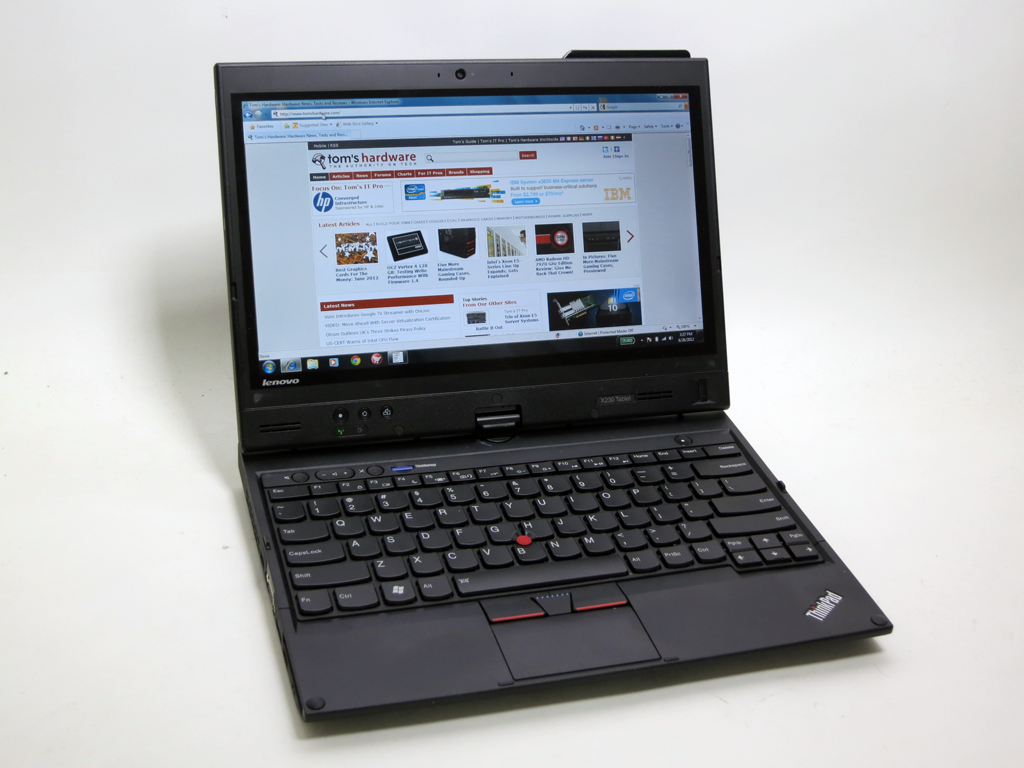
Despite their limitations, tablets continue to interest us. Instant-on availability, one-handed operation, touch screen user interfaces, and comprehensive connectivity make them ideal travel companions. In contrast, notebooks are nearly impossible to operate unless you're sitting still. And they're overkill for reading articles and e-books.
The tablet PC turns out to be a really cool compromise, serving as a compact notebook and convenient tablet in one device. Tablet PCs have been around for years, but the lack of a true touch screen-enabled Windows operating system limited their popularity. As tablets come down in price (and size), opportunities for tablet PCs to really take off seem to continue drying up.
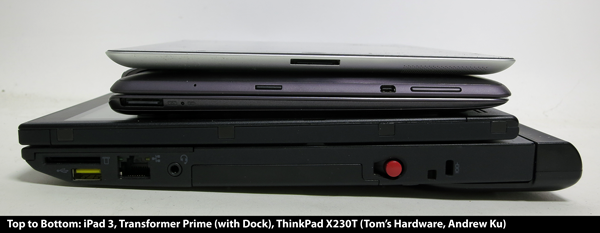
Unfortunately, we'll need to wait until Windows 8 launches before realizing the full potential of next-gen tablet PCs combining notebook and tablet functionality. The good news is that Lenovo is one of a handful of vendors still willing to carry the torch, even ahead of Windows 8. Its newest Ivy Bridge-based X230T is a convertible tablet in the company's ThinkPad X series, nearly identical to the Sandy Bridge-based X220T that came before.
The X230T employs a rugged magnesium alloy shell that will please professionals, though the palm rests and keyboard frame made of matte black plastic may be more susceptible to damage from rough handling.
Get Tom's Hardware's best news and in-depth reviews, straight to your inbox.
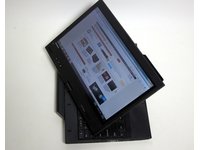
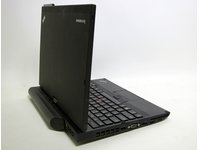
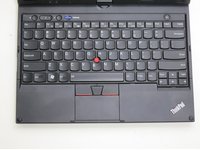
Converting the X230T from its notebook configuration to a more tablet-like setup is easy. Twist the display clockwise (it only moves in one direction) to turn the screen around, and then close the lid. The screen orientation automatically switches from landscape to portrait, and you're ready to go. Lenovo also enables three hotkeys on the screen: orientation (to switch between landscape and portrait), Ctrl+Alt+Del, and sleep.

It's easiest to use the X230T in tablet mode with a digitizer pen that Lenovo bundles. It's stored internally, and easily ejected by pressing down on its red top from the right side of the chassis. Though the X230T is touch screen-enabled, the digitizer pen helps enable more accurate control of the tablet PC-specific features in Windows 7. If you're not already familiar with how Windows 7 works on a tablet PC, check out Windows 7: Tablet PC Features.
Our only concern about the X230T's body involves left-handed users. If you are a southpaw, holding the X230T in tablet mode points the internal exhaust vent toward your body. Naturally, as the thing heats up, you end up taking the brunt of the thermal output.
| Specifications | Lenovo ThinkPad X230T |
|---|---|
| CPU | Core i5-3320M (Ivy Bridge), 2.6 GHz, 3 MB Shared L3 Cache, 2C/4T, 35 W TDP, 22 nm |
| Screen | 12.5" IPS LED WXGA (1366x768) |
| Memory | 4 GB DDR3-800 SO-DIMM |
| System Drive | Hitachi 320 GB (HTS723232A7A364) |
| Graphics | Intel HD 4000 Graphics, 650 MHz Base Frequency, 1.2 MHz Max. Dynamic Frequency |
| Operating System | Windows 7 Professional |
| Wireless | 802.11b/g/n |
Current page: A Rare Tablet PC Catches Our Attention
Next Page CPU Performance: Comparing Tablets And Tablet PCs-
greghome The problem I see with the X-T series Convertible tablets though, is that for the same price I can purchase a X230 and a Thinkpad Tablet and still have money left.Reply
I can imagine a market for it, but once the Thinkpad Tablet 2 launches with Windows 8, I'd say there market would grow even smaller. just my 2 cents :) -
ojas Hmmm interesting to see the A5 just about manage to keep up with the two year old Atom N450.Reply
Anyway, Tom's: X1 Carbon review please! :D
Read that its trackpad is best-in-class for a Windows laptop. -
Zetto These machines should come with the leather sleeve included, it really comes into it's own in the sleeve.Reply
I've carried an older model around all day for years, the battery lasts 8 hrs easy with a good power profile setup and intermittent use.
OneNote is gold on it.
My users often borrow it just for it's presentation benefits as well.
This new model will shine with Win 8. -
jaquith As a past owner of the IBM/Lenovo Convertible I very rarely used it as a 'Tablet.' However, with Windows 8, and I don't like Windows 8, you'd probably use the 'Tablet' mode a lot more.Reply
I use an HP EliteBook Mobile Workstation and have little desire to go back to the Tablets.
Originally I wanted folks to be able to 'sign contracts' out in the field, but in practice Paper wins. -
cknobman Lets see:Reply
Big, thick, heavy
Ugly
Crappy battery life
When you think about it I could:
Buy an Asus Zenbook 1080p for $999
Google Nexus tablet for $199
Both combined would be as thin and light (or thinner/lighter) than this lenovo contraption while offering superior battery life and screen quality (at least on the ultrabook).
This product just seems like a fail. -
cknobman - you're really not the target market for this thing. They're fantastic for health care, home health, etc.Reply
-
greghome cknobmanLets see:Big, thick, heavyUglyCrappy battery lifeWhen you think about it I could:Buy an Asus Zenbook 1080p for $999Google Nexus tablet for $199Both combined would be as thin and light (or thinner/lighter) than this lenovo contraption while offering superior battery life and screen quality (at least on the ultrabook).This product just seems like a fail.Reply
From your post, I'd say you've never really used a IBM Thinkpad before.
The Thinkpad lines were never meant for normal consumers like you. If you've compared to built quality as well, the Thinkpads, especially the T and W series are wonders.
and unlike the ZenBooks or Macbooks......you can step on them and the hinge will be able to stand it. -
cknobman greghomeFrom your post, I'd say you've never really used a IBM Thinkpad before.The Thinkpad lines were never meant for normal consumers like you. If you've compared to built quality as well, the Thinkpads, especially the T and W series are wonders.and unlike the ZenBooks or Macbooks......you can step on them and the hinge will be able to stand it.Reply
Actually I've used ThinkPads a lot as I am a software developer. Two of my last 4 jobs issued them to the developers as their primary workstations. ThinkPad build quality, usability, design are all top notch for business users.
My comment was in response to the way this article was phrased. This article was not necessarily written in the context of a business user and actually was slanted more towards personal use and its ability to replace a tablet and laptop combo while traveling.
In that context I do see this product as a fail. -
Wisecracker I thought it was common knowledge that Acer and Compal have Trinity Win* Tab-hybrids coming out next month -- may even be articles on Toms about it.Reply
I can't really recall but pricing was something "less than $900" with Brazos II models substantially less.